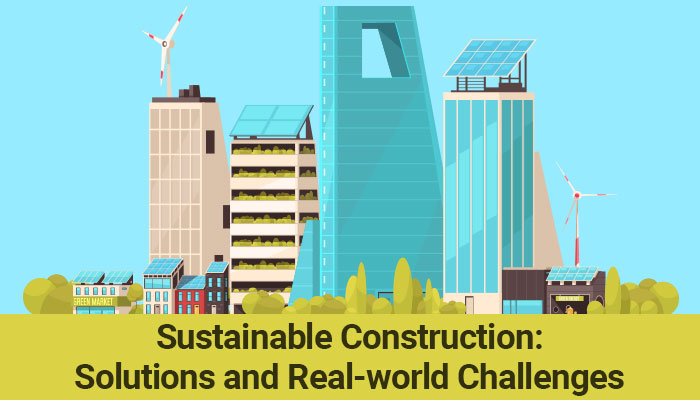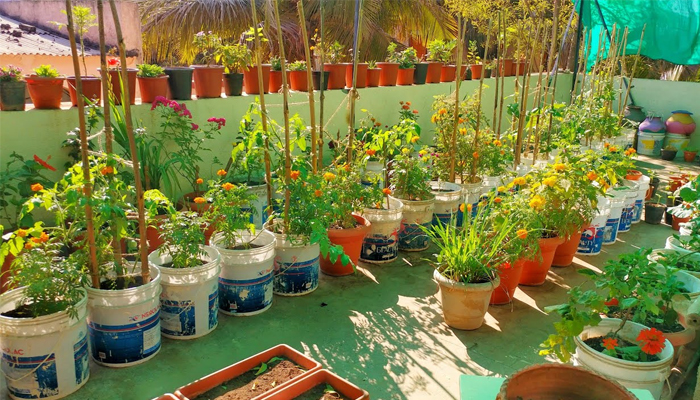Sustainability Lessons from a Spitian Village
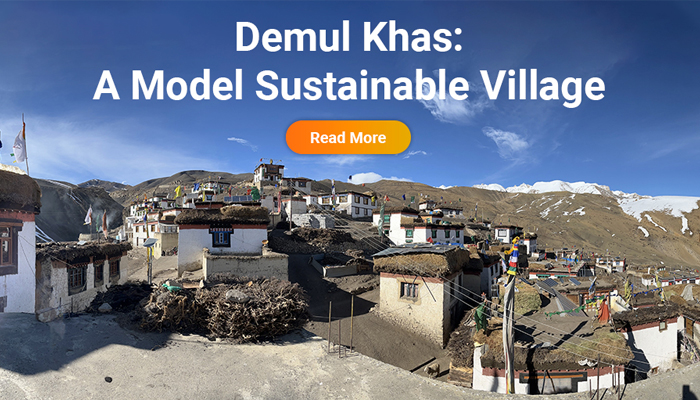
The author undertook an immersive, zero carbon trip with a local NGO, Spiti Ecosphere, to experience the villages of Spiti and Kinnaur. Serving as a precursor to IIFL Home Loan's upcoming Model Village, this photo essay documents the local construction techniques and circular economy practices, which make Demul, a truly model sustainable village belonging to Himachal Pradesh, India. With a focus on green housing practices, the author attempts to highlight the ingenuity of vernacular architectural knowledge prevalent in remote villages of cold desert regions in Northern India.

A Village Cut off From Rest of The World During Winters
Perched at an altitude of 14,170 feet (4300 m) from the sea level and nestled amidst the high altitudes and cold desert of the Himalayan ranges, lies a small village called Demul Khas, spread over 165 acres. The village is connected by a single laned road, which is functional only during summer months. The village is cut off from the rest of the world as soon as the snow hits and continues to prosper off-grid even during the long winter. To live in such harsh conditions is not an easy task, which is why it is so sparsely populated. However, the village folk assure us of the beauty and joy in its culture, marked by peaceful community life, inner contentment, resilience and harmony with nature and its forces.
Known for its unique community-home stay system, it is fast emerging as the model sustainable village of Spiti. Through this photo essay, let us dive inside the life in Demul in the spring of 2023.
History and Folklore
-
Story of Human Settlement
According to the village folklore, the first settler in Demul Khas arrived around 800 years ago. It is believed that a lone nomad’s cattle wandered away from a nearby hill to graze the relatively fertile fields of Demul. They had unknowingly brought with them barley seeds in their hooves and shoes which accidentally fell and got sown in the field. In a few months, when they returned to the place, they noticed that barley grain had germinated and sprouted. The evidence of fertile land for cultivation convinced the wanderer to set base in Demul Khas, and thereafter led to the growth of the settlement as it stands today.
-
Political System/Governance Structure
Demul Gram Panchayat consists of 4 villages, Demul Khas being one of the prominent ones. The village has a Pradhan as the intermediary between the government and the village community. However, the villagers have devised some interesting informal self-governing systems to ensure equity and fairness for all its people. One such system is the community managed and equitably distributed, homestay-led tourism arrangement.
-
Community System of Homestays
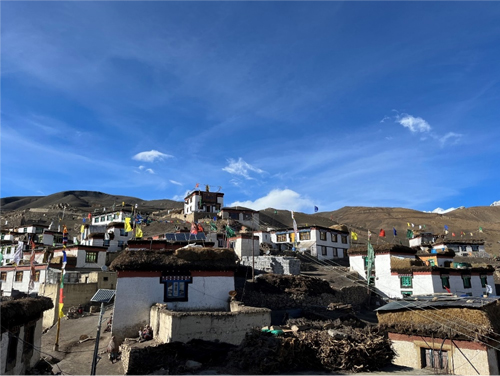
Starting more than a decade back, the village community adopted a unique system of responsible, community-led tourism, by providing equal opportunity to every villager to host their home as homestay. Initiated by a local NGO, Spiti Ecosphere, it has been running successfully ever since.
As per this system, out of the total 50 homes, half of the homes are dedicated for homestay in one tourism year and the remaining 25 get to host in the succeeding year. This system of rotation ensures that every house gets a chance to host tourists and travelers, gain exposure and generate revenue from this activity. Post November, as the tourism season ends, money is collected by two coordinators and redistributed equitably to all the 25 homestay owners. A proper registry is maintained by these coordinators to ensure transparency. The cycle is repeated for the remaining homestays in the next tourism season.
Our hosts were extremely happy with this system and ensured that although the stay is in one house, the tourists/travelers get to enjoy the taste and hospitality of the entire village community who come together to share their stories, local life experiences and of course Aloo momos , yak cheese and the famous local brew, Arak!
-
Geography
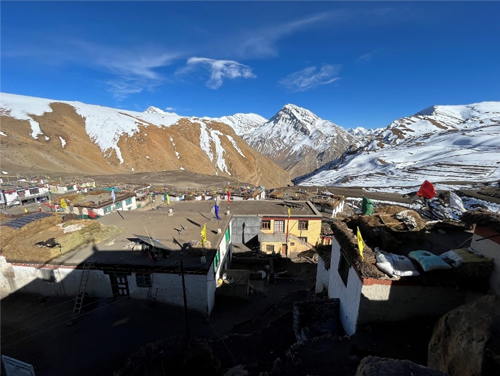
Demul Khas lies in the Cold desert of Spiti, also known as the land between Tibet and India. Being a rain shadow area, it receives little to no rainfall. However, snowfall is quite abundant. The weather is mostly windy, with low humidity and low temperature (reaching almost -15 degree at night in April!). Together this makes it a difficult terrain for vegetation, except in the few summer months between May to August wherein the valley gets covered in grassy green, something the locals took great pride in, and for all the right reasons!
Due to its location, geography and topography, the only source of water is the melting glaciers, which the villagers have, over centuries learned to divert and optimize for their drinking, irrigation and other domestic needs through a series of sedimentation tanks/kuls.
-
Agriculture
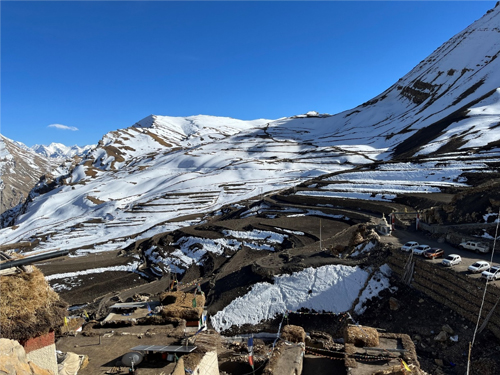
The short summer period between April/May (sowing) to August/September (harvest) is the window for growing crops. The harvest is stored for the remainder of the cold and long winters, mainly for self consumption by the villagers. Therefore, only such crops are grown which have a larger shelf life, such as barley, peas and potatoes. Rice, wheat and pulses are not grown locally, but procured through the Government’s Targeted Public Distribution System which provides subsidies for APL, BPL categories of villagers based on the ration cards. For other food items and groceries, the villagers have to travel around 30 kilometers to the closest town, i.e. Kaza.
Barley, in addition to being the staple, is also used for the preparation of Demul’s famous brew, Arak. The quality of this organic high altitude barley whisky is so potent that it attracted an MoU with a Polish spirits company for its “grain to glass project”. Under this MoU, contract farming is being promoted amongst the farmers of Lahaul and Spiti for growing high yield barley variety. The resultant barley will be used for making the world’s first, organic, Himalayan single malt whisky.

The irrigation system devised by the locals uses a simple and indigenous system of tanks/kuls which filters the glacial melt through sedimentation and natural processes, capitalizing on the natural gradient and channeling this filtered water to fields and homes through pipes.
The village is also embracing modern technologies to enhance agricultural produce by creating multiple improved greenhouses. Spinach and green vegetables are now being successfully grown and consumed by the villagers even during winter months, along with apples, apricots and sea buckthorn (male version). In the cold desert villages, these fruits are dried and consumed as dry fruits after the cold season is over. The structural design for these greenhouses is simple and relies on the three principles of optimal orientation, black absorbent paint, and well insulated walls. A wooden frame is then created, and plastic sheets are laid on top to enclose the area.

To ensure the interior is well insulated, local knowledge and materials are put to use in the form of walling, plaster and orientation. The total width of the wall is 22 inches, out of which 12 inch exterior wall is earthen followed by a 4 inch gap which is filled with hay and thatch and the next layer of wall is 6 inch mud wall again (See section below).The 4 inch gap between the two walls ensures that the heat gain during the day is slowly radiated to the inner walls and interiors, preventing the temperature within to stay well out of the minus degree mark.
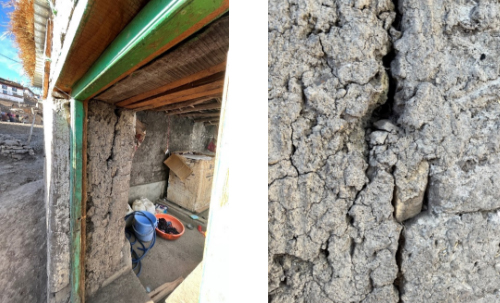
Livestock farming is also a crucial part of agriculture. Yak, sheep, mules, cows and even poultry are domesticated and utilized for their wool, milk and meat, and fertilisers. In fact, each home has an attached shed for cattle and other livestock, ensuring housing for all beings!
-
Waste
As opposed to the water-based sewage system which has contaminated the ground water table of the region, the locals prefer to and even advocate for retaining the traditional dry compost toilet system wherein human excreta is mixed with dry manure and collected in an underground pit. The dry compost manure is later used as an organic fertilizer for agriculture, thereby completing the nutrient cycle. The process takes around 2 years, wherein underground rooms are divided into two sections, where one section is used for a year and closed for the next, for drying purposes. These toilets were found located both inside homes and, in some cases, were created as a separate unit outside the house. Although the thought of using such a system may sound repulsive at first for a flush user, adoption of this system in water scarce geographies was both logical and ecological.

In fact, not too far away, in Leh, where such toilets are the norm, a WASH project has been initiated by the local government and Ladakh ecological development group (LEDeg), to upgrade the dry compost toilet. Using solar energy to produce good manure, keeping the pit below ground (8 feet under the surface) level to prevent freezing of fecal sludge, an attached wash basin within the toilet compartment were some of its main tenements.
-
Energy

One thing that strikes a visitor is the marriage of modern solar energy systems with traditional lifestyles. Every rooftop had a functional solar panel (providing 1 bulb for each house) and the streets and public places had solar lights installed at key points. Grid electricity is said to have arrived here around 35 years back. Solar streetlights have been provided by the Government through subsidies over the last 1 year with the installation being done by villagers themselves while the maintenance is done periodically by the Government . Additionally, the efforts and initiatives of local NGOs such as Spiti Ecosphere have ensured that any gaps in energy are also provided for, through a local solar power plant. A point to be noted was that Solar heating here has not reaped successful results due to the incidents of pipe bursting due to the freezing temperatures.
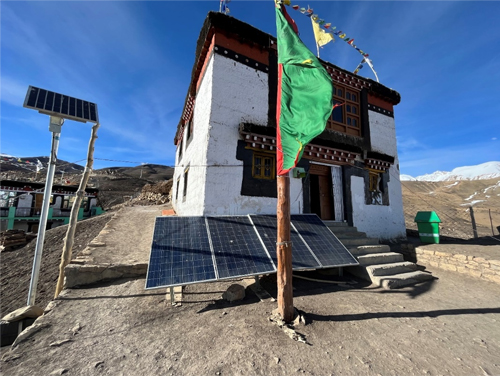
This harmony between modern and traditional through the adaptation of the best of both worlds was a key lesson in implementing development initiatives. Local knowledge and vernacular practices, when fused with context appropriate technology can create a respectful development solution which facilitates people’s participation in development.
-
Livelihoods
Although agriculture and ecotourism are predominant activities, the villagers are increasingly also taking up jobs in construction, as contractors, government jobs,etc. The women have taken to weaving in addition to being homemakers .Most of the women have organized themselves into a self help group initiated by an NGO and are involved in hand weaving of different items such as woolen apparels, shawls, carpets and the like. The activity uses local sheep and yak wool as their raw materials, ensuring circular economy in practice at a local level.
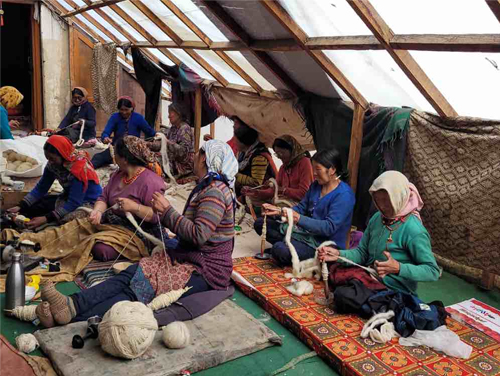
-
Architecture

The main construction materials include mud, stone, and wood, all of which are locally sourced. Modern materials like cement have started making inroads but mainly for plastering purposes. There is a general consensus on the efficacy of thick mud/stone walls for insulation, which cement or red clay bricks have not been able to replace. Further, both these materials are not locally available and the cost factor plays a deterrent role in their adoption.
In terms of the typical layout, a long corridor with rooms on either side is predominant. The kitchen, interestingly, doubles up as the living, drawing and dining room. It is the most used space and the largest. With a central chimney linked to the wood fired iron pan, it utilizes both radiation and induction to warm the room on the one hand and heat the food on the other. It must be noted that the design and construction is done entirely by the local masons. In Demul, around 10 to 15 such masons were residents, who get hired by the home owners to construct their respective homes. One house typically takes one year to complete.
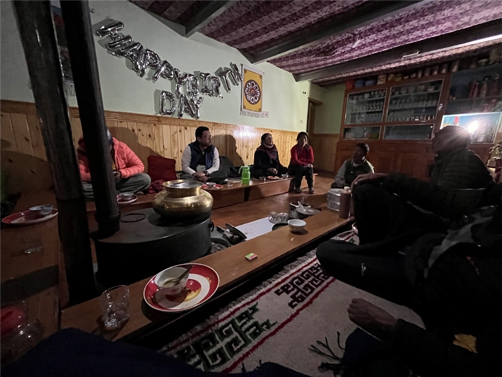
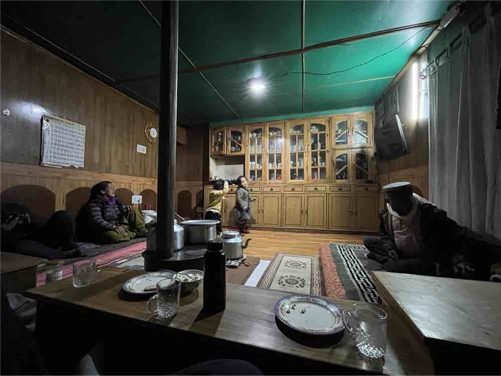
Walling is mostly earthen, with both interior and exterior being constructed in mud, using rammed earth technique of wall construction, wherein local mud is mixed with water to form a moistened mix/slurry. It is then poured in a formwork made by placing two planks (wooden here) parallel to each other and perpendicular to the ground. The local masons then press it down using their feet (the other technique being handheld wooden rammers). The thickness of the exterior wall was 18 inch while the interior walls could range between 16 to 18 inches. This, as per the local guide, provided considerable insulation for the house and the temperature difference was noticeably different with the interior feeling much warmer than the frigid conditions outside.
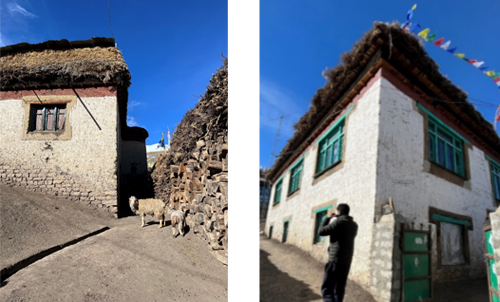
Local stone, available openly as loose rocks in the mountain was used as random rubble masonry for the foundation and plinth for all traditional houses (and also for boundary wall); on top of which the earthen walls were constructed using rammed earth. The mortar used was mud mortar in traditional homes. However, some elements of modern construction were starting to make their inroads by now.

Cement. The boon and bane of modern construction was increasingly being used for plastering internal and external walls. In newly constructed buildings and homes, Cut Stone Blocks were being used as walling, with cement mortar and cement plaster. Reinforced Cement Concrete was used as the frame with rammed earth walls as infill. The mix of modern with traditional was most visible through these construction practices. However, the insulation effect of this composite mix is yet to be established and approved by the community.

Roofing is mostly flat, made using local timber (branches of the local Poplar tree) as the beams and plastered on top with mud (locally available). Normally animal fodder is stored on the roof top, for the long winter months, in addition to the solar panels! Recently, precast reinforced concrete joists and steel sections have also started being used as beams, but these are costlier to procure due to the additional cost of transportation.
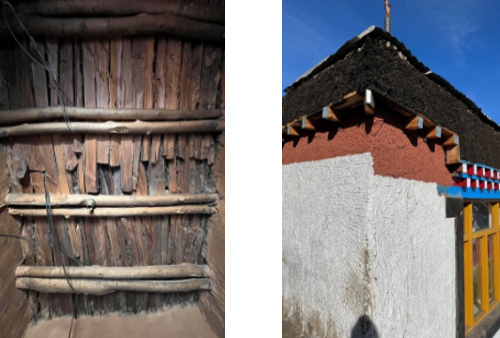

Flooring is done in earth and topped with mud slurry at the ground floor. For upper floor, a tight wooden beam structure is made and thereafter secured with mud slurry (similar to the roof).
Fenestration. Small sized windows, made of wood, are typical to the cold desert architecture. These ensure structural stability of the house while also providing increased insulation against the winter. However, newer construction is going for larger windows, to maximise the sun. Skylights were also made in some homes.
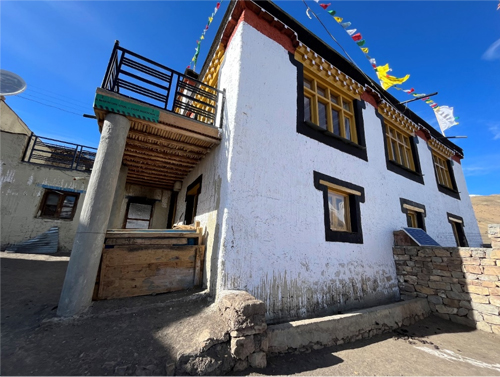
-
Conclusion
The village LIFE (lifestyle for environment) provides crucial lessons for sustainable living, especially for urban India, which is increasingly detached from nature, except for the small moneyplants in every balcony. To understand where and how our food comes from, what goes behind our room heaters and how to live in harmony with nature are all interlinked with SDG’s. Lessons in climate adaptation, mitigation and resilience need not be overcomplicated. Going back to basics and our roots may just be a good starting point for developing upon our diverse cultures, geographies, and ingenuities. The plethora of vernacular knowledge needs to be researched and amalgamated with modern principles for the collective good. Respect for the local knowledge and ingenuity must be given priority, along with their aspirations.
While governments are aiming to capitalize on the natural resource potential of these pristine and self sustaining systems, caution must be paid to “development” projects which prioritise economic benefits over long term ecological benefits. While the projects for contract farming for high yield varieties is a good attempt, the long term environmental impact of such initiatives must be thoroughly assessed and researched, especially since past experiences (Green Revolution) of such varieties have left large swatches of some of our most fertile plain areas.
Climate change is most visible and starkly observed by the locals who live in harmony with the cold desert. According to them, there has been a drastic reduction in the amount of snowfall over the past 3-4 years, in addition to shifting seasons, prolonged winters, changing patterns of snow, loss of agriculture and water scarcity.
True nature based solutions and circular economy principles are already in practice in our villages. However, the villages, being at the forefront of climate change adversaries may just be lost in mindless “development” and economic pursuits of a few, compromising the lives, livelihoods and most importantly the traditional knowledge pool. The People-planet harmony which has been established by them over centuries must be furthered, rather than reduced.
Tags
Disclaimer: The information contained in this post is for general information purposes only. IIFL Home Finance Limited (including its associates and affiliates) ("the Company") assumes no liability or responsibility for any errors or omissions in the contents of this post and under no circumstances shall the Company be liable for any damage, loss, injury or disappointment, etc. suffered by any reader. All information in this post is provided "as is", with no guarantee of completeness, accuracy, timeliness, or of the results, etc. obtained from the use of this information, and without warranty of any kind, express or implied, including, but not limited to warranties of performance, merchantability, and fitness for a particular purpose. Given the changing nature of laws, rules, and regulations, there may be delays, omissions, or inaccuracies in the information contained in this post. The information on this post is provided with the understanding that the Company is not herein engaged in rendering legal, accounting, tax, or other professional advice and services. As such, it should not be used as a substitute for consultation with professional accounting, tax, legal or other competent advisers. This post may contain views and opinions which are those of the authors and do not necessarily reflect the official policy or position of any other agency or organization. This post may also contain links to external websites that are not provided or maintained by or in any way affiliated with the Company and the Company does not guarantee the accuracy, relevance, timeliness, or completeness of any information on these external websites. Any/ all (Home/ Loan Against Property/ Secured Business Loan/ Balance Transfer/ Home Improvement Loan/ NRI Home Loan/ Home Loan for Uniformed Services) loan product specifications and information that may be stated in this post are subject to change from time to time, readers are advised to reach out to the Company for current specifications of the said (Home/ Loan Against Property/ Secured Business Loan/ Balance Transfer/ Home Improvement Loan/ NRI Home Loan/ Home Loan for Uniformed Services) loan.
 Login
Login









